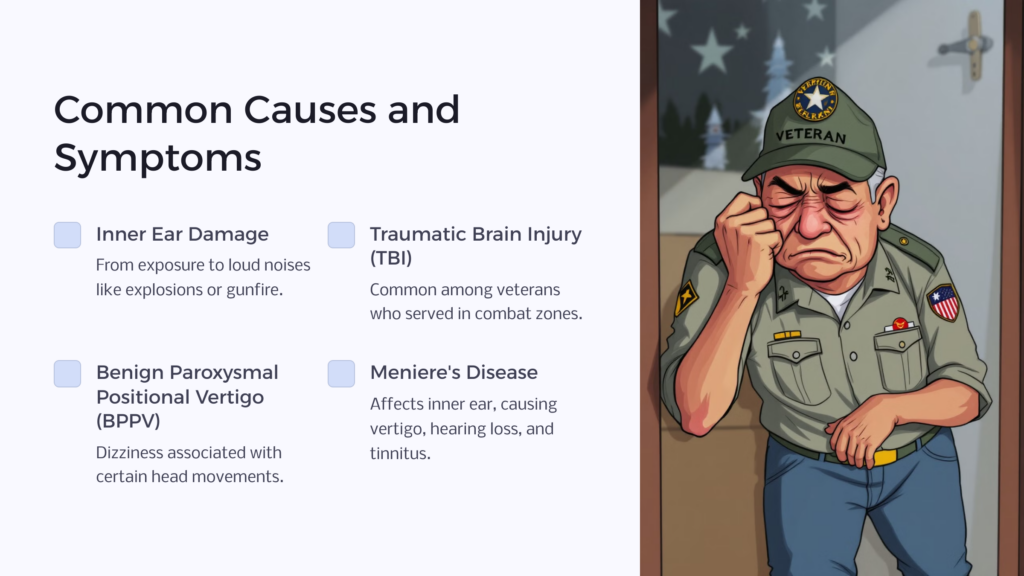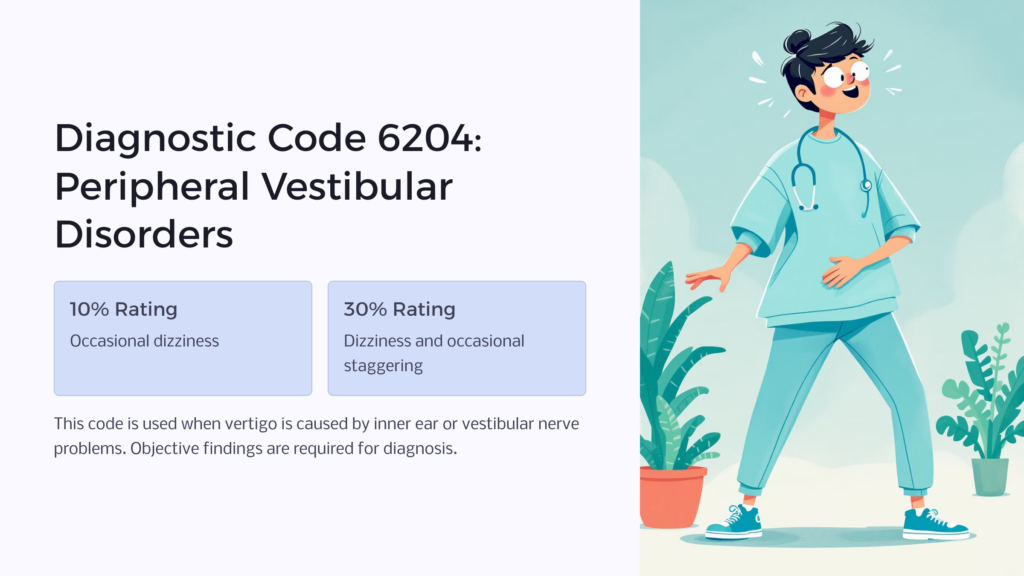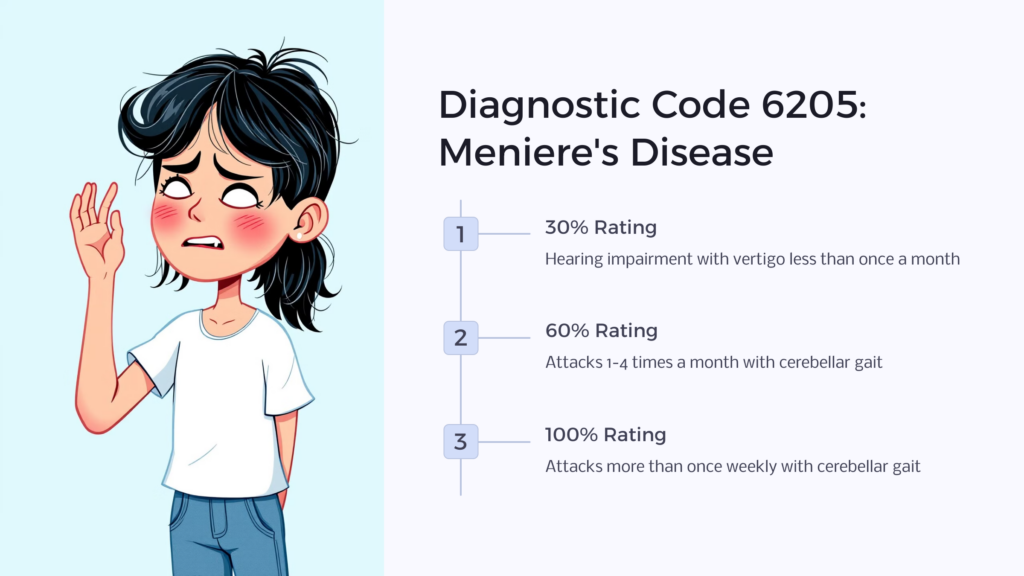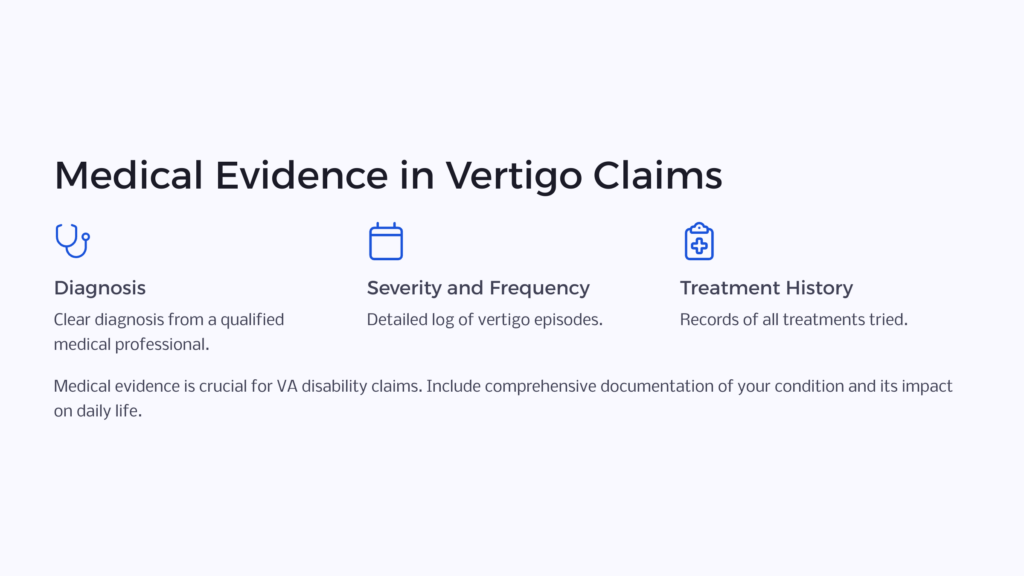Vertigo is a medical condition that causes a person to feel like they or the environment around them is spinning or moving when it’s not. It may be a symptom of other conditions such as a vestibular balance disorder. For veterans, dealing with vertigo can be especially challenging, as it can interfere with daily activities and even their ability to work. Many veterans experience vertigo as a result of their military service, whether from exposure to loud noises, as a result from head trauma injuries, or other factors.
The spinning sensation of vertigo can be mild and brief, or severe and long-lasting. Some veterans may feel dizzy for just a few seconds, while others might struggle with symptoms for hours or even days. This unpredictability can make it difficult for veterans to plan their days or maintain steady employment
Veterans with vertigo often report feeling off-balance, nauseous, and even vomiting. These symptoms can be frightening and may lead to anxiety about when the next episode will occur. For many veterans, vertigo isn’t just a physical challenge – it can also take a toll on their mental health and overall quality of life.
Common Causes and Symptoms of Vertigo

There are several reasons why veterans might develop vertigo. One common cause is damage to the inner ear, which can happen from exposure to loud noises like explosions or gunfire. Another cause is traumatic brain injury (TBI), which is unfortunately all too common among veterans who have served in combat zones.
Some veterans develop what’s called benign paroxysmal positional vertigo (BPPV) and experience dizziness associated with certain head movements due to displaced crystals in their inner ear. Others may experience vertigo as part of Meniere’s disease, which also affects the inner ear and can cause hearing loss and recurrent tinnitus (ringing in the ears).
Symptoms of vertigo can vary but often include:
- A spinning sensation
- Feeling off-balance or unsteady
- Nausea and vomiting
- Headaches
- Sweating
- Abnormal eye movement (nystagmus)
- Ringing in the ears (tinnitus)
- A feeling of fullness in the ear
It’s important for veterans experiencing these symptoms to seek medical attention. A proper diagnosis can help determine the underlying cause and effective treatment options.
VA Disability Ratings: An Overview
The Department of Veterans Affairs (VA) provides disability compensation for veterans whose service-connected conditions affect their ability to work and carry out daily activities. For vertigo, the VA uses a rating system to determine the level of disability and corresponding compensation.
VA disability ratings are given in percentages, ranging from 0% to 100%. A higher percentage indicates a more severe disability and results in greater compensation. For vertigo, ratings typically fall under two main diagnostic codes: 6204 for peripheral vestibular disorders and 6205 for Meniere’s disease.
It’s crucial to understand that the VA doesn’t just look at the vertigo itself, but also considers how it impacts your daily life and ability to work. They’ll review your medical records, service history, and any supporting evidence you provide to determine your rating.
The process of getting a VA rating for vertigo can be complex, but it’s important for veterans to pursue the benefits they’ve earned through their service. Don’t hesitate to seek help from Veterans Service Organizations or legal professionals who specialize in VA claims if you need assistance navigating the process.
Diagnostic Code 6204: Peripheral Vestibular Disorders

When rating vertigo, the VA will use Diagnostic Code 6204 for peripheral vestibular disorders when vertigo is caused by problems in the inner ear or the vestibular nerve, which connects the inner ear to the brain.
Under this code, there are two possible ratings:
- 10% rating: Occasional dizziness
- 30% rating: Dizziness and occasional staggering
To qualify for the 10% rating, veterans need to show that they experience feeling off-balance or that the room is spinning from time to time.
For the higher 30% rating, veterans must demonstrate not only dizziness but also occasional staggering. This means that the vertigo is severe enough to affect their ability to walk steadily at times. It’s important to note that the VA requires “objective findings” to support this diagnosis. This usually means that a doctor has observed or documented your symptoms.
Remember, these ratings are based on how often and how severely vertigo affects you. It’s crucial to keep detailed records of your symptoms and how they impact your daily life. This information can be very helpful when applying for or appealing a disability rating.
Diagnostic Code 6205: Meniere’s Disease

Meniere’s disease is a disorder of the inner ear that can cause severe vertigo along with hearing loss and tinnitus (ringing in the ears). The VA rates Meniere’s disease under Diagnostic Code 6205, which offers higher ratings than the code for peripheral vestibular disorders.
Here’s how the VA rates Meniere’s disease:
- 30% rating: Hearing impairment with vertigo less than once a month, with or without tinnitus
- 60% rating: Hearing impairment with attacks of vertigo and cerebellar gait occurring from one to four times a month, with or without tinnitus
- 100% rating: Hearing impairment with attacks of vertigo and cerebellar gait occurring more than once weekly, with or without tinnitus
A “cerebellar gait” refers to an unsteady, staggering walk that looks like the person is drunk. It’s a sign that the vertigo is severely affecting balance and coordination.
It’s important to note that the VA will rate Meniere’s disease based on its individual symptoms (vertigo, hearing loss, and tinnitus) if that results in a higher overall rating. This means they’ll look at each symptom separately and combine the ratings.
For veterans dealing with Meniere’s disease, keeping a detailed log of vertigo attacks, including their frequency and severity, can be crucial for getting an accurate rating. Don’t forget to document how these attacks affect your daily life and ability to work.
Understanding Secondary Conditions Related to Vertigo
Vertigo rarely occurs in isolation. Many veterans experience related conditions that can be considered “secondary” to their vertigo. Understanding these secondary conditions is important because they may increase your overall VA disability rating.
One common secondary condition is anxiety. The unpredictable nature of vertigo attacks can lead to constant worry about when the next episode might occur. This anxiety can be severe enough to warrant its own disability rating.
Depression is another potential secondary condition. Living with chronic vertigo can be frustrating and isolating, potentially leading to depression. If you’re experiencing symptoms of depression related to your vertigo, it’s important to discuss this with your healthcare provider and document it for your VA claim.
Migraines are also frequently associated with vertigo. Some veterans experience what’s known as vestibular migraines, where the headache is accompanied by severe dizziness. If you’re having migraines along with your vertigo, make sure to report this to your doctor and include it in your VA claim.
Remember, for the VA to consider these as secondary conditions, you’ll need to show that they’re directly related to or aggravated by your service-connected vertigo. Medical evidence and doctor’s opinions can be crucial in establishing these connections.
How to Apply for Vertigo Disability
Applying for vertigo disability benefits begins with filing a claim. You can do this online through the VA’s website, by mail, or in person at your local VA office. Here’s a step-by-step guide:
- Gather your evidence: Collect all your medical records related to your vertigo, including diagnoses, treatment plans, and how it affects your daily life.
- Fill out the application: Use VA Form 21-526EZ for new claims or VA Form 21-526b for secondary or increased rating claims.
- Submit your claim: Send in your application along with all your supporting evidence.
- Attend a C&P exam: The VA may schedule you for a Compensation and Pension exam to evaluate your condition.
- Wait for a decision: The VA will review your claim and send you a decision letter.
It’s important to be as thorough as possible when filing your claim. Include details about how your vertigo affects your work and daily activities. If you’re claiming vertigo as secondary to another service-connected condition (like hearing loss or TBI), make sure to clearly explain this connection.
Don’t be discouraged if your initial claim is denied. Many veterans need to go through the appeals process before receiving the rating they deserve. If you’re unsure about any part of the process, consider seeking help from a Veterans Service Organization or a lawyer specializing in VA claims.
The Role of Medical Evidence in Vertigo Claims

When it comes to VA disability claims for vertigo, medical evidence plays a crucial role. The VA needs to see clear, documented proof of your condition and how it impacts your life.
Here’s what you should focus on:
- Diagnosis: You need a clear diagnosis of vertigo or a related condition (like Meniere’s disease) from a qualified medical professional.
- Service connection: If possible, provide evidence linking your vertigo to your military service. This could be service medical records showing treatment for dizziness or head injuries.
- Severity and frequency: Keep a detailed log of your vertigo episodes. Note how often they occur, how long they last, and how severe they are.
- Impact on daily life: Document how vertigo affects your ability to work, drive, or perform everyday tasks. Letters from family members or coworkers detailing their observations of your symptoms can also be helpful.
- Treatment history: Include records of all treatments you’ve tried, whether they helped or not.
Remember, the more detailed and comprehensive your medical evidence, the stronger your claim will be. Don’t hesitate to ask your doctor for help in documenting your condition. A medical opinion linking your vertigo to your military service can be particularly powerful evidence.
If you’re having trouble getting the necessary medical evidence, consider asking the VA for help. They have a duty to assist veterans in obtaining relevant records for their claims.
Appealing a Denied VA Vertigo Claim
If your initial claim for vertigo is denied, don’t lose hope. Many veterans have to go through the appeals process before receiving the VA benefits they deserve. Here’s what you need to know about appealing a denied claim:
- Understand why your claim was denied: Carefully read the decision letter from the VA. It should explain why your claim was denied and what evidence was missing.
- Choose your appeal lane: Under the new Appeals Modernization Act, you have three options:
- Higher-Level Review: A senior VA employee reviews your existing claim.
- Supplemental Claim: You can submit new evidence to support your claim.
- Appeal to the Board of Veterans’ Appeals: Your case goes directly to a Veterans Law Judge.
- Gather additional evidence: If your claim was denied due to lack of evidence, focus on getting the missing information. This might include more detailed medical records or a new medical opinion.
- Meet deadlines: Pay close attention to the deadlines for filing your appeal. Missing a deadline could mean having to start the process over.
- Consider getting help: The appeals process can be complex. A Veterans Service Organization or a lawyer specializing in VA claims can provide valuable assistance.
Remember, persistence is key when appealing a VA decision. Many veterans are successful on appeal, especially when they provide new, compelling evidence to support their claim. Don’t give up on getting the benefits you’ve earned through your service.
Tips for Maximizing Your VA Disability Rating for Vertigo
Getting the right VA disability rating for your vertigo is crucial for receiving the benefits you deserve. Here are some tips to help maximize your rating:
- Be thorough in your documentation: Keep a detailed log of your vertigo episodes, including frequency, duration, and severity. Note how they affect your daily activities and work.
- Get a buddy statement: Ask family members, friends, or coworkers to write statements describing how they’ve seen vertigo impact your life.
- Consider all related symptoms: Don’t forget to mention other symptoms like tinnitus, hearing loss, or balance problems. These could increase your overall rating.
- Be honest about bad days: When describing your condition, focus on how you function on your worst days, not your best.
- Attend all VA exams: Missing a Compensation and Pension (C&P) exam can hurt your claim. Always attend these appointments and be honest about your symptoms.
- Consider secondary conditions: If your vertigo has led to other issues like anxiety or depression, make sure to include these in your claim.
- Seek regular medical treatment: Consistent medical records provide strong evidence for your claim. Regular check-ups show the VA that your condition is ongoing and serious.
Remember, the goal is to paint an accurate picture of how vertigo affects your life. Don’t exaggerate, but don’t downplay your symptoms either. With thorough documentation and persistence, you can work towards getting the disability rating you deserve.
Common Mistakes to Avoid in Vertigo Claims
When filing a VA disability claim for vertigo, there are several common mistakes that veterans should be aware of and try to avoid:
- Underestimating symptoms: Some veterans downplay their symptoms, thinking they need to “tough it out.” This can lead to a lower rating than you deserve. Be honest about how vertigo affects your life.
- Lack of medical evidence: Not having enough medical documentation is a common reason for claim denials. Make sure you have a clear diagnosis and ongoing treatment records.
- Missing deadlines: The VA has strict deadlines for filing claims and appeals. Missing these can seriously delay your claim or even require you to start over.
- Not explaining the service connection: If you’re claiming vertigo as secondary to another service-connected condition, make sure to clearly explain this connection.
- Giving up after a denial: Many veterans get discouraged after an initial denial and don’t appeal. Remember, many claims are approved on appeal.
- Not considering all rating options: Sometimes, rating individual symptoms separately can result in a higher overall rating than a single rating for Meniere’s disease. Consider all possibilities.
- Doing it alone: The VA claims process can be complex. Don’t hesitate to seek help from a Veterans Service Organization or a qualified attorney.
By avoiding these common pitfalls, you can strengthen your claim and increase your chances of receiving the rating you deserve. Remember, persistence and thorough documentation are key to a successful claim.
Resources and Support for Veterans with Vertigo
Living with vertigo can be challenging, but there are resources available to help veterans cope with this condition and navigate the VA claims process:
- VA Health Care: The VA provides comprehensive health care services for eligible veterans. This includes diagnosis and treatment for vertigo and related conditions. Visit the VA’s health care website for more information.
- Veterans Service Organizations (VSOs): Organizations like the Disabled American Veterans (DAV) and Veterans of Foreign Wars (VFW) offer free assistance with VA claims. They can help you prepare your claim and represent you before the VA.
- VA Caregiver Support: If you need assistance due to your vertigo, the VA offers support for caregivers. Learn more on the VA Caregiver Support website.
- Vestibular Disorders Association: This non-profit organization provides information and support for people with vestibular disorders, including vertigo. Visit their website for educational resources and support group information.
- National Center for PTSD: If your vertigo is related to traumatic brain injury or PTSD, the National Center for PTSD offers valuable resources. Check out their website for more information.
- Legal Help: If you need legal assistance with your VA claim, organizations like the National Veterans Legal Services Program offer pro bono help to veterans.
Remember, you’re not alone in dealing with vertigo. Don’t hesitate to reach out for support, information, and assistance. With the right help and persistence, you can work towards getting the care and benefits you need and deserve. Our team will help you with the complex process of getting the disability benefits you deserve.
 Benefits.com Advisors
Benefits.com Advisors
With expertise spanning local, state, and federal benefit programs, our team is dedicated to guiding individuals towards the perfect program tailored to their unique circumstances.
Rise to the top with Peak Benefits!
Join our Peak Benefits Newsletter for the latest news, resources, and offers on all things government benefits.



















